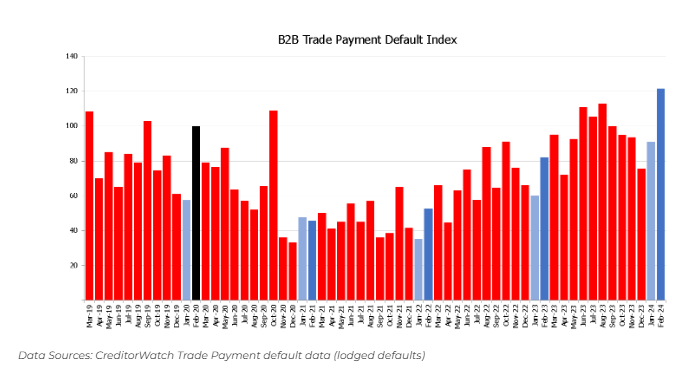The February 2024 CreditorWatch Business Risk Index (BRI) has revealed that payment defaults from business-to-business transactions are at record highs. This comes as a direct result of the increasing cost pressures that Australian businesses are confronting from factors such as higher interest rates, inflation, wages and labour shortages, coupled with lower consumer demand as households struggle to manage cost-of-living pressures.
CreditorWatch’s data shows businesses in the food and beverage services sector to be at the highest risk of all industries for external administrations and forecast business failures. Spending at restaurants and entertainment venues is not expected to increase until early 2025 when interest rate cuts have eased cost-of-living pressure for consumers.
The data on payment defaults has a strong correlation with business failures. Businesses with one default have a 24% chance of going insolvent in the next 12 months. This rises to 42% for two defaults against two businesses and 62% for three defaults against three businesses.

Last month CreditorWatch reported that the average value of invoices was at a record low. This was also reflected in last week’s ABS Business Indicators for the December quarter, which showed businesses were running down their inventories in anticipation of further declines in consumer demand.
While the February BRI data recorded a seasonal increase in the average value of invoices from January to February (up 10.4%) values continue to trend downward and sit at their lowest point since September.
The BRI data has been pointing towards a rapidly slowing economy for some time now, and this has now been reflected in the December quarter Australian National Accounts.
Gross Domestic Product (GDP) grew by a very slow 0.2% over the December quarter, taking the annual growth rate to 1.5%. However, in per capita terms, GDP has been negative for three straight quarters, which means Australia is in a ‘per capita’ recession. The sustained fall in the average value of invoices over 2023 was a very good leading indicator of the overall slowing of the economy.
External administrations
The rate of external administrations is now well above pre-COVID levels. Unfortunately, given the decline in the average value of trade invoices and the record level of trade payment defaults recorded in February, we expect that the rate of external administrations will continue to increase over 2024.
The public administration and safety; mining and electricity, gas, water and waste services industries have all recorded the largest increase in external administrations against this time last year. There are numerous sub-sectors within these industry categories, such as security companies and waste management services that are facing very challenging conditions and a slowdown in demand.
The food and beverage services sector still has the highest rate of external administrations, and this sector is expected to remain to maintain its unenviable position at the top of this table as Australians pull back their spending at restaurants and on takeaway in the face of cost-of-living pressures.
Forecast business failure rate by industry
Business failures consider external administrations as well as ASIC strike offs – so the closure of a business for various reasons. Over the next 12 months we expect just over 7% of all food and beverage services business to shut their doors. The agriculture, forestry and fishing industry is much more stable, with only 3.28% of businesses in this sector expected to close.
Outlook
Based on BRI data coming through and models projecting external administrations and business failures, we expect the next six months, at least, to be very challenging for Australian businesses. All businesses will need to watch their cash flow very closely, even when the cash rate begins to decline, which at this stage looks to be sometime in Q3 2024.
It will take three or four cuts to the cash rate before Australian consumers start to feel more comfortable making purchases of discretionary items and spending on entertainment, which is unlikely to be until early 2025.
CreditorWatch is an Associate Member of the Drinks Association.